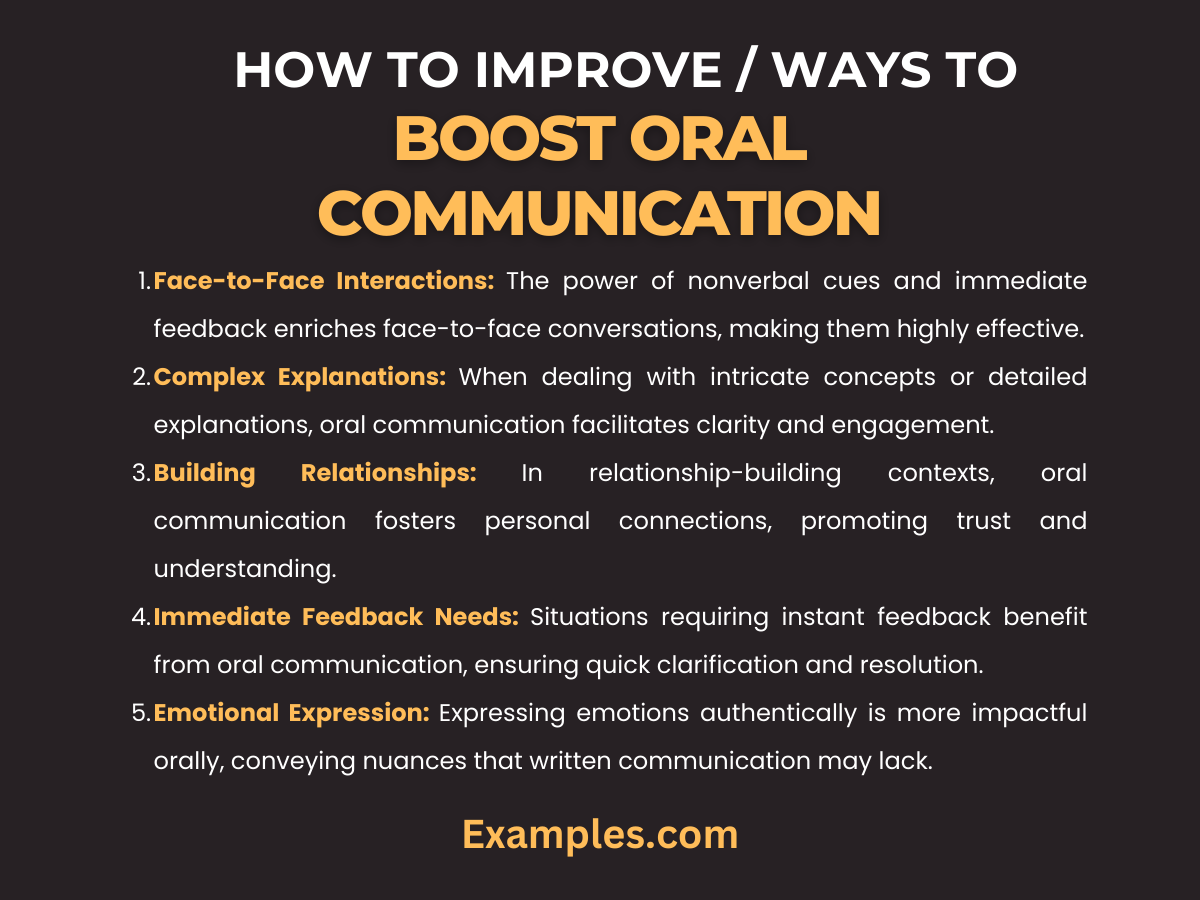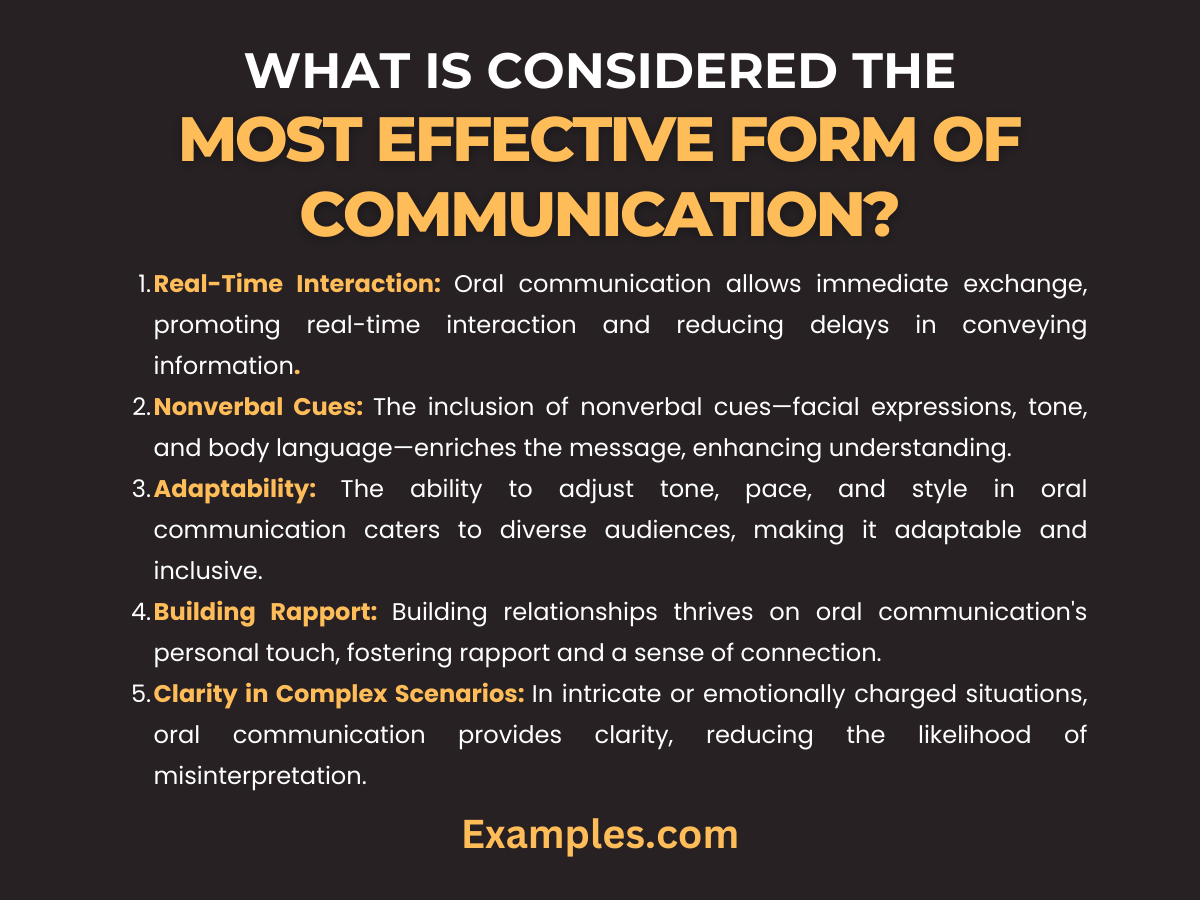How to Improve / Ways to Boost Oral Communication?
Embark on a journey to refine your oral prowess with our comprehensive guide on How to Improve / Ways to Boost Oral Communication. Uncover dynamic strategies, supported by real-life Communication Examples, designed to enhance your verbal skills. From effective listening to impactful expression, master the art of articulate and compelling communication, empowering you in every personal and professional interaction. Elevate your oral proficiency and captivate your audience with newfound confidence.
How to Improve / Ways to Boost Oral Communication
Effective oral communication flourishes in specific circumstances. Delve into the scenarios where oral communication shines, providing insights on leveraging its power. Uncover the nuances that make spoken words impactful, enhancing your ability to connect and convey messages with precision.

Understand the Circumstances: Effective oral communication prevails in dynamic settings, such as:
- Face-to-Face Interactions: The power of nonverbal cues and immediate feedback enriches face-to-face conversations, making them highly effective.
- Complex Explanations: When dealing with intricate concepts or detailed explanations, oral communication facilitates clarity and engagement.
- Building Relationships: In relationship-building contexts, oral communication fosters personal connections, promoting trust and understanding.
- Immediate Feedback Needs: Situations requiring instant feedback benefit from oral communication, ensuring quick clarification and resolution.
- Emotional Expression: Expressing emotions authentically is more impactful orally, conveying nuances that written communication may lack.
What is considered the most effective form of communication?
While various communication forms exist, uncover why oral communication stands out as one of the most effective channels. Explore its unique attributes and advantages that make it an indispensable tool for successful interactions.

- Real-Time Interaction: Oral communication allows immediate exchange, promoting real-time interaction and reducing delays in conveying information.
- Nonverbal Cues: The inclusion of nonverbal cues—facial expressions, tone, and body language—enriches the message, enhancing understanding.
- Adaptability: The ability to adjust tone, pace, and style in oral communication caters to diverse audiences, making it adaptable and inclusive.
- Building Rapport: Building relationships thrives on oral communication’s personal touch, fostering rapport and a sense of connection.
- Clarity in Complex Scenarios: In intricate or emotionally charged situations, oral communication provides clarity, reducing the likelihood of misinterpretation.
What are the three factors affecting oral communication?
Unlock the secrets to masterful oral communication by delving into the key factors shaping its effectiveness. Explore how clarity, active listening, and contextual adaptability play pivotal roles in refining your verbal skills. Understanding and honing these factors can significantly elevate your ability to convey messages seamlessly in any setting.
- Clarity of Expression: Achieving clarity in your communication involves articulating thoughts with precision. Learn techniques to streamline your expression, ensuring your messages are easily understood.
- Active Listening: Dive into the art of active listening, a cornerstone of effective oral communication. Discover strategies to engage attentively, comprehend nuances, and respond thoughtfully.
- Contextual Adaptability: Tailor your communication style to suit different contexts and audiences. Master the skill of adapting your approach, whether in the workplace, classroom, or personal settings.
What are the 5 principles of effective oral communication?
Elevate your communication game by embracing the five fundamental principles that define effective oral expression. From clarity and engagement to adaptability and empathy, these principles empower you to leave a lasting impression in any interaction.

- Clarity and Conciseness: Articulate your thoughts with clarity and conciseness. Master the art of delivering focused and easily comprehensible messages, avoiding unnecessary complexity.
- Engagement and Connection: Forge a strong connection with your audience through engaging delivery. Utilize storytelling, relatable examples, and interactive elements to captivate and connect.
- Adaptability and Flexibility: Embrace flexibility in your communication style, adjusting to different situations and audiences. Learn to navigate diverse contexts with ease.
- Empathy and Understanding: Cultivate empathy by acknowledging the emotions and perspectives of your audience. An empathetic approach fosters positive and meaningful exchanges.
- Feedback Integration: Actively seek and incorporate feedback into your communication. Continuous refinement based on feedback ensures ongoing improvement and effectiveness.
In enhancing oral communication, it is crucial to recognize that the journey of improvement is ongoing. The skills discussed, such as clarity in expression, active listening, and contextual adaptability, are not one-time achievements but areas of continuous growth. For further development in this area, exploring high-quality resources is beneficial. One such resource is the comprehensive guide on effective communication from HelpGuide.org. This guide delves into the subtleties of communication skills, emphasizing the importance of engaged listening, understanding nonverbal cues, managing stress, and assertiveness. It offers valuable insights into not just sharing information but also grasping the emotions and intentions behind it, thus improving both personal and professional relationships. You can explore these insights in detail at HelpGuide.org’s Effective Communication.
Moreover, for professionals seeking to enhance their communication skills in the workplace, Harvard’s Division of Continuing Education provides practical tips and strategies. Their article “8 Ways You Can Improve Your Communication Skills” addresses key aspects like clarity, preparation, nonverbal communication, tone, active listening, emotional intelligence, developing a workplace communication strategy, and creating a positive organizational culture. These guidelines are particularly relevant in today’s fast-paced and diverse business environments, offering a roadmap for effective leadership and successful business interactions. You can access these expert tips at Harvard DCE’s Communication Skills Improvement Guide.



